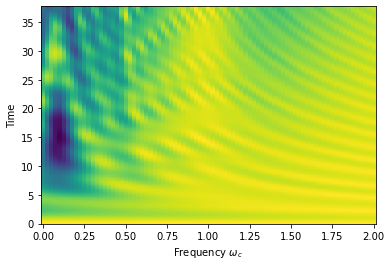[1]:
import quanguru as qg
import numpy as np
import matplotlib.pyplot as plt
import platform
19 - Simultaneous Simulation JC and Rabi models#
This is a tutorial for open system dynamics of JC.
[2]:
# parameters for the Hamiltonian
qubitFreq = 1
cavityFreq = 1
couplingFreq = 0.25
cavityDim = 5
# parameters for the evolution
totalTime = 3*(np.pi/couplingFreq)
timeStep = 0.1
[3]:
# Qubit for the JC model
QubitJC = qg.Qubit(frequency=qubitFreq)
# Cavity for the JC model
CavityJC = qg.Cavity(dimension=cavityDim, frequency=cavityFreq)
# JC model consists of a qubit and cavity
# and this is the 'free evolution' part of the JC-Hamiltonian
JCSystem = QubitJC + CavityJC
[4]:
# Rabi model also consists of a qubit and cavity
RabiSystem = JCSystem.copy()
[5]:
# create the JC coupling using built-in coupling extension
JCSystem.JC(couplingFreq)
RabiCoupling = RabiSystem.Rabi(couplingFreq)
[6]:
# simulation contains the systems, protocol, and sweeps
simulation = qg.Simulation(subSys=[JCSystem, RabiSystem])
# simulation stores the evolution parameters
simulation.stepSize = timeStep
simulation.totalTime = totalTime
# initial state of the simulation
simulation.initialStateSystem = JCSystem
simulation.initialState = [1, 1]
freqSweep = simulation.Sweep.createSweep(
system=[CavityJC, "Cavity2"],
sweepKey="frequency",
sweepMax=qubitFreq+cavityFreq,
sweepMin=qubitFreq-cavityFreq,
sweepStep=.025)
[7]:
compositeSZ = qg.compositeOp(qg.sigmaz(), dimA=cavityDim)
# calculate the desired results and store
def compute(sim, args):
stateJC = args[0]
stateRabi = args[1]
res = sim.qRes
res.singleResult = ['zRabi', qg.expectation(compositeSZ, stateRabi)]
res.singleResult = ['zJC', qg.expectation(compositeSZ, stateJC)]
res.singleResult = ['fidJC', qg.fidelityPure(stateRabi, stateJC)]
simulation.compute = compute
IMPORTANT NOTE FOR WINDOWS USERS : MULTI-PROCESSING (p=True) DOES NOT WORK WITH NOTEBOOK
You can use a python script, but you will need to make sure that the critical parts of the code are under if __name__ == "__main__": We are going to add further tutorials for this later.
[8]:
# do not store the states
simulation.delStates = True
# run the simulation
# p=True uses multi-processing for the sweep
simulation.run(p=(platform.system() != 'Windows'))
[8]:
[]
[9]:
Y, X = np.meshgrid(simulation.timeList, freqSweep.sweepList)
plt.pcolormesh(X, Y, simulation.resultsDict['zJC'])
plt.xlabel("Frequency $\omega_{c}$")
plt.ylabel("Time")
[9]:
Text(0, 0.5, 'Time')

[10]:
Y, X = np.meshgrid(simulation.timeList, freqSweep.sweepList)
plt.pcolormesh(X, Y, simulation.resultsDict['zRabi'])
plt.xlabel("Frequency $\omega_{c}$")
plt.ylabel("Time")
[10]:
Text(0, 0.5, 'Time')

[11]:
Y, X = np.meshgrid(simulation.timeList, freqSweep.sweepList)
plt.pcolormesh(X, Y, simulation.resultsDict['fidJC'])
plt.xlabel("Frequency $\omega_{c}$")
plt.ylabel("Time")
[11]:
Text(0, 0.5, 'Time')
